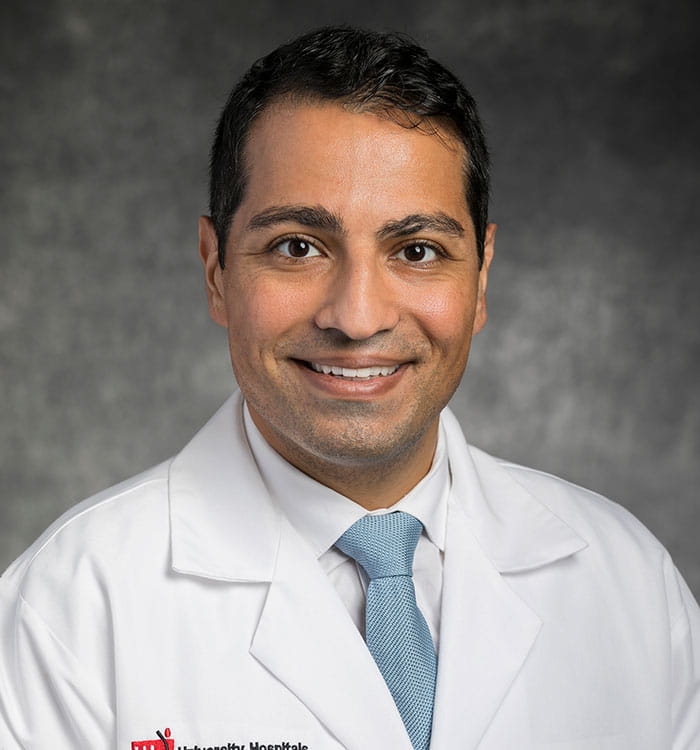Advancements in Facial Reanimation Bring New Hope to Patients Living with Paralysis
May 23, 2023
Innovations in Ear, Nose & Throat | Summer 2023
Individuals living with facial nerve disorders require a multidisciplinary continuum of care. “If somebody comes to me with facial nerve paralysis, that is often not their primary issue,” says Cyrus Rabbani, MD, a facial plastic and reconstructive surgeon in the Department of Otolaryngology – Head and Neck Surgery at University Hospitals Cleveland Medical Center. “They are often coming to me after being told they have cancer or one of a plethora of diseases, primarily Bell’s Palsy. I tell people we are not just treating their facial nerves; we are here to provide comprehensive facial care.”
 Cyrus Rabbini, MD
Cyrus Rabbini, MDPatients diagnosed with facial nerve injury may experience a full, partial or lack of recovery. Some exhibit facial synkinesis, involuntary facial movement caused by abnormal regeneration of the nerves that control the facial musculature. Examples include an asymmetrical appearance, facial tightening or squinting when trying to smile.
“Typically, the primary treatment modality has been facial retraining through physical therapy, with or without Botox injections. However, we have found that a subset of patients benefits from a novel surgical therapy known as selective neuromyectomy,” says Dr. Rabbani. Double board-certified by the American Board of Otolaryngology – Head and Neck Surgery and the American Board of Facial Plastic and Reconstructive Surgery, he leads the facial reanimation program at University Hospitals Ear, Nose & Throat Institute.
Also known as selective neurolysis, neuromyectomy requires advanced surgical expertise. “The procedure has gained popularity over the past half-decade and utilizes time-honored facial plastic techniques, but we are applying them in a specialized manner,” explains Dr. Rabbani. “We go in and selectively denervate some of the facial musculature and/or remove certain muscles to help improve facial symmetry and restore a more natural appearance.”
Using incisions around the ear and hairline, Dr. Rabbani employs advanced techniques to approach the facial nerves and muscles with minimal scarring. He also utilizes leading-edge technology, including nerve monitoring systems and CHECKPOINT GEMINI™—a bipolar nerve stimulation probe that generates nerve and muscular assessments intraoperatively.
“These are complicated surgeries that are possible because of University Hospitals’ resources as a nationally ranked academic medical center,” says Dr. Rabbani. “It takes a team effort in the operating room. You need a strong anesthesia and nursing team, and then we have residents and trainees who assist and learn these techniques.” Postoperatively, a patient’s treatment team may include oculoplastic surgeons, ophthalmologists, neurotologists, plastic surgeons, and speech and physical therapists.
A Full Spectrum of Treatment Options
In cases of complete paralysis, Dr. Rabbani offers alternative options for facial reinnervation and muscle transfer. “This can include free muscle transfer from other parts of the body in order to reanimate the face,” he explains. “We are working to offer more expeditious care for our patients with abnormal facial nerve recovery because many have been told for a very long time that there was not much that would help them.”
Early intervention in the setting of abnormal facial nerve recovery requires strategic patient tracking and referrals to establish care with these patients sooner along their journey. Dr. Rabbani works closely with his neurosurgical, neurotology, and head and neck colleagues who treat patients with facial tumors or temporal bone trauma. Providers throughout Northeast Ohio also refer patients to University Hospitals as the facial reanimation program continues to grow.
Whatever disease state or trauma a patient is coping with, the goal is to restore as much function and aesthetic appearance as possible. “And that doesn't start or end with me,” says Dr. Rabbani. “Patients are entering the realm of care that we offer, and it helps to know that I have these expert colleagues doing their due diligence to ensure each individual receives the proper course of treatment. That is what I like best about being here at UH.”
For more information or to refer a patient, contact Dr. Rabbani at Cyrus.Rabbani@UHhospitals.org.
Contributing Expert:
Cyrus Rabbani, MD
Facial Plastics and Reconstructive Surgeon
Department of Otolaryngology – Head and Neck SurgeryUniversity Hospitals Cleveland Medical Center
Assistant Professor
Case Western Reserve University School of Medicine


